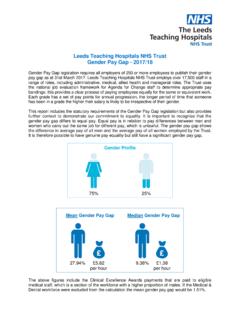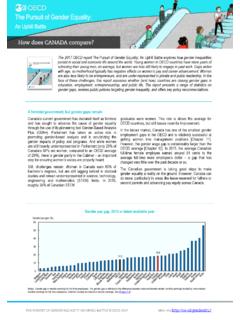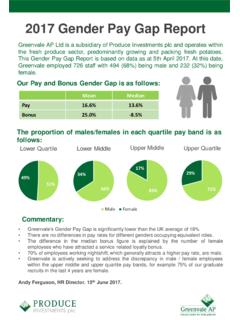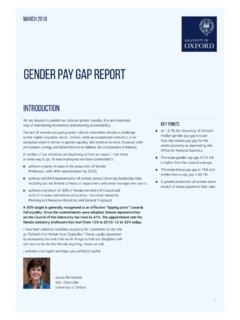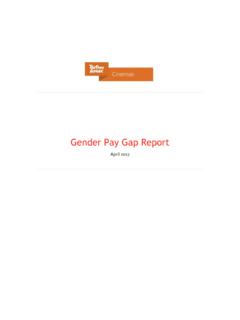Transcription of Health and Safety Executive Gender Pay Gap …
1 Health and Safety Executive Gender Pay Gap Report 2017 Published January 2018 Foreword by Karen Nightingall, Director, People and Capability This report is an important part of seeking assurance on the equality of our pay systems, and for helping us to understand and address any emerging issues in relation to Gender . It will support our ongoing work to improve the diversity of our workforce and reform our overall reward offering. HSE is committed to building and maintaining a diverse and inclusive organisation with equality of opportunity at the heart of this. We have made significant progress in modernising our reward strategy to enable everyone in HSE to be recognised individually regardless of grade or Gender . Some recent improvements include: The introduction of spot rates for our junior grades to enable consistent movement through pay ranges. Reducing the length of our pay ranges generally to an average length of approximately 10% with aspirations to go further. This will help enable us to address any remaining variation in pay for similar roles.
2 Reforming bonus awards so that they are paid as a set value as opposed to a percentage of salary, and are no longer prorated for part-time staff. This ensures equality of payment regardless of grade, Gender or contracted hours. Introduction of a new in-year reward and recognition scheme. The distribution of these payments will be carefully monitored to ensure equality. Taking steps to improve how we recruit women into senior and higher paid specialist roles including the introduction of anonymised recruitment, and ensuring Gender balance on selection panels. There is clearly scope for us to make further improvements, particularly in the proportion of women employed in senior posts and specialist technical and engineering roles which are amongst our most highly paid jobs. Attracting female engineers is a challenge we share with the wider UK economy and it is an unavoidable fact that fewer women are currently employed in these sectors. Together with my HSE Management Board colleagues, we are fully committed to improving further our position in relation to Gender pay.
3 Karen Nightingall Health and Safety Executive Gender Pay Gap Report 2017 Published January 2018 Introduction Earlier this year, the Government introduced world-leading legislation that made it statutory for organisations with 250 or more employees to report annually on their Gender pay gap. Government departments are covered by the Equality Act 2010 (Specific Duties and Public Authorities) Regulations 2017 which came into force on 31 March 2017. These regulations underpin the Public Sector Equality Duty and require the relevant organisations to publish their Gender pay gap data by 30 March 2018 (and then annually), including mean and median Gender pay gaps; the mean and median Gender bonus gaps; the proportion of men and women who received bonuses; and the proportions of male and female employees in each pay quartile. The Gender pay gap shows the difference in the average pay between all men and women in a workforce. If a workforce has a particularly high Gender pay gap, this can indicate there may be a number of issues to deal with, and the individual calculations may help to identify what those issues are.
4 The Gender pay gap is different to equal pay. Equal pay deals with the pay differences between men and women who carry out the same jobs, similar jobs or work of equal value. It is unlawful to pay people unequally because they are a man or a woman. The Health and Safety Executive supports the fair treatment and reward of all staff irrespective of Gender . This report sets out where the Health and Safety Executive fulfils the reporting requirements, analyses the figures in more detail and sets out what we are doing to close the Gender pay gap in the organisation. Health and Safety Executive Gender Pay Gap Report 2017 Published January 2018 Definitions and scope The Gender pay gap is defined as the difference between the mean or median hourly rate of pay that male and female colleagues receive. The mean pay gap is the difference between average hourly earnings of men and women. The median pay gap is the difference between the midpoints in the ranges of hourly earnings of men and women.
5 It takes all salaries in the sample, lines them up in order from lowest to highest, and picks the middle-most salary. The report is based on rates of pay as at 31 March 2017 and bonuses paid in the year 1 April 2016 31 March 2017. It includes all workers in scope at 31 March 2017. Health and Safety Executive Gender Pay Gap Report 2017 Published January 2018 HSE Gender pay indicators Mean Gap The difference between the mean* hourly rate of pay of men and women *Average pay for all men and average for all women employees This is the difference in hourly rate of men ( ) and women ( ) Median Gap The difference between the median* hourly rate of pay of men and women *middle value of pay for all men and middle value for all women employees This is the difference in hourly rate of men ( ) and women ( ) Mean Bonus Gap The difference between the mean* bonus paid to men and women *Average bonus for all men and average for all women employees This is the difference in bonus pay of men ( ) and women ( ) Median Bonus Gap The difference between the median* bonus pay paid to men and women *The middle values of bonuses paid to all men compared to all women employees 0% Difference in bonus payment of men ( 595)
6 And women ( 595) Bonus Proportions The proportions of men who were paid a bonus and women paid a bonus of men received a bonus payment compared to of women Quartile Pay Bands The proportions of men and women in the lower; lower middle; upper middle and upper quartile Men Women Q1(Lower) Q2 Q3 Q4(Upper) Health and Safety Executive Gender Pay Gap Report 2017 Published January 2018 Summary of results The results show that HSE has a mean Gender pay gap of and a median Gender pay gap of We are confident that this is not an equal pay issue there is equal treatment for work of equal or similar value and when we examine Gender pay by grading level the gap becomes much narrower, particularly at senior levels. The pay gap is negligible within Senior Civil Service (SCS) grades and for HSE Board members there is no Gender pay gap at all. The is also a relatively small gap in our senior professional and operational roles (Band 1 and Band 2 level) where the mean pay gap is and the median Encouragingly for the future, there is a negligible pay gap at Band 4 level which is the entry grade for our trainee Health and Safety inspectors, and a middle management level for our scientific roles and corporate services.
7 Within our junior grades (where we have made significant pay reforms) the pay gap is in favour of women. We have a specific issue at Band 3 level which has the widest Gender pay gap ( ). The majority of our specialist inspectors are employed at this grade and many of these roles require specific technical and engineering skills and experience and therefore attract a pay premium. The make-up of this group reflects the wider industry picture (and our main recruitment market) where relatively small numbers of women are employed. When we examine particular specialisms, however, we are confident that HSE pays equally for similar skills, for example the relative pay gap between male and female engineers is negligible. Overall, the analysis shows that a key factor in the Gender pay gap for HSE is that there are fewer women working in specialist, technical and engineering roles which attract higher levels of pay (33% of our people in specialist roles are women). Health and Safety Executive Gender Pay Gap Report 2017 Published January 2018 Further analysis A further breakdown of HSE data for 2017 shows that across specific peer groups (grading level), the Gender pay gap is far less pronounced.
8 Note All figures in the tables below are rounded to one decimal place. A minus figure shows pay in favour of women. Proportion of men and women at each grading level Overall, HSE employs an equal proportion of men (1368) and women (1356). See Table 1. Women predominate the lower grades (Bands 4 6) with the proportion of men employed greater in the higher grades (Bands 1 -3 and SCS levels). Gender pay gap at each grading level The overall mean Gender pay gap is and median Gender pay gap is The pay gap narrows when it is broken down by each grading level. See Tables 2 and 3. For our senior leadership roles within Senior Civil Service (SCS) grades, and Band 4 level (which is our entry grade for trainee Health and Safety inspectors) the Gender pay gap is negligible. For HSE Board Members there is no Gender pay gap. The pay gap is in favour of women for Bands 5 and 6. The gap is less pronounced in other senior roles at Band 1 and Band 2 level where the mean pay gap is up to and the median Table 1 - HSE number of men and women employed at each grading level as at 31st March 2017 (SIP) Gender Band 1 Band 2 Band 3 Band 4 Band 5 Band 6 Board Member SCS Grand Total Male 56 244 593 189 150 111 5 20 1368 Female 28 115 390 233 287 291 4 8 1356 Grand Total 84 359 983 422 437 402 9 28 2724 %Female Health and Safety Executive Gender Pay Gap Report 2017 Published January 2018 Table 2 - HSE mean Gender pay gap at each grading level Mean Gender pay gap (hourly rate)
9 Band 1 Band 2 Band 3 Band 4 Band 5 Band 6 Board Member SCS HSE Hourly pay rates of men divided by number of men Hourly pay rates of women divided by number of women Mean Gap Table 3 - HSE median Gender pay gap at each grading level Median Gender pay gap (hourly rate) Band 1 Band 2 Band 3 Band 4 Band 5 Band 6 Board Member SCS HSE Midpoint in the range of hourly earnings for men Midpoint in the range of hourly earnings for women Median Gap Health and Safety Executive Gender Pay Gap Report 2017 Published January 2018 Bonus Awards HSE paid bonus awards to 89% of all staff - of men received a bonus payment compared to of women. The mean bonus gap was and there was no gap for the median. Actions HSE is committed to continuing to reduce its Gender pay gap and has a range of initiatives in place to do this, including: Recruitment We will review our advertising and marketing approach with a view to increasing the number of women recruited to specialist technical and engineering roles.
10 These roles are amongst our most highly paid jobs. In line with Cabinet Office guidance, HSE has already anonymised the Civil Service job application process. Our recruitment strategy requires that all selection panels include female representation to ensure Gender balance. Flexible Working HSE is committed to delivering its business more effectively by creating modern workplaces, we actively promote flexible working to support employees with caring responsibilities and encourage work-life balance and wellbeing. Around one third of our employees have flexible working arrangements. In order to provide parents with more flexibility in how to share time off work after their child is born or placed for adoption, we encourage and support a shared parental leave policy. Development Programmes HSE actively promotes participation in its talent and leadership development programmes such as the Positive Action Pathway, open to colleagues from protected characteristic groups that are not appropriately represented in HSE.










